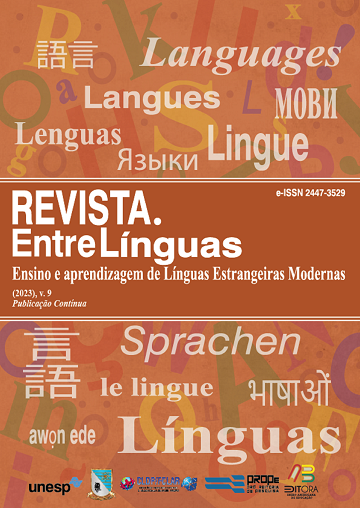Relações entre a escrita e a fala na primeira língua e sua influência no uso de Inglês como Língua Adicional
Uma reflexão sobre o ensino de pronúncia
DOI:
https://doi.org/10.29051/el.v9i00.17208Palavras-chave:
Escrita ortográfica, Leitura, Inglês como LAResumo
Este artigo propõe uma discussão acerca das relações grafofonêmicas e fonografêmicas em português brasileiro, segundo as propostas de Capovilla e Casado (2014a, 2014b), para a avaliação da produção ortográfica (na escrita) e falada (na leitura em voz alta) de aprendizes brasileiros de inglês como língua adicional. Mais especificamente, é apresentada, por meio de uma reflexão que coteja a teoria supracitada, uma proposta de entendimento sobre as paralexias e paragrafias possivelmente encontradas na produção linguística de aprendizes de inglês. Com base nas relações entre a escrita e a fala (relações grafofonêmicas) e entre a fala e a escrita (relações fonografêmicas) do português brasileiro, discutem-se casos em que relações consagradas nesta língua podem afetar a produção da fala e da escrita de aprendizes de inglês.
Downloads
Referências
CALLOU, D.; LEITE, Y. Iniciação à fonética e à fonologia. Rio de Janeiro: Zahar, 2003.
CAPOVILLA, F. C.; CASADO, K. Quebrando o código do português brasileiro: Como calcular a cifrabilidade de qualquer palavra falada e a decifrabilidade de qualquer palavra escrita. São Paulo: Memnon, 2014a.
CAPOVILLA, F. C.; CASADO, K. Voz brasileira na Nova Ortografia: As Vozes das Letras: CD-ROM e Manual. São Paulo: Memnon, 2014b.
CAPOVILLA, F. C. Nossa Língua Portuguesa: Como avaliar o grau de cifrabilidade de qualquer palavra falada e o grau de decifrabilidade de qualquer palavra escrita nas normas lusitana e brasileira. In: PEREIRA, R. (org.). Abordagem Multidisciplinar da Aprendizagem. 1. ed. Viseu, Portugal: Qual Consoante, 2015. v. 1, p. 405-504
CARLEY, P.; MEES, I. M.; COLLINS, B. English Phonetics and pronunciation practice. Nova York: Routledge, 2018.
CELCE-MURCIA, M.; BRINTON, D. M.; GOODWIN, J. M. Teaching Pronunciation: A course book and reference guide. Nova York: Cambridge University Press, 2010.
CRISTÓFARO-SILVA, T. Pronúncia do inglês para falantes do português brasileiro. São Paulo: Contexto, 2015.
ECKMAN, F. R. Second Language Phonology. In: GASS, S. M.; MACKEY, A. (org.). The Routledge handbook of second language acquisition. Nova York: Routledge, 2012.
ELLIS, N. C.; ROBINSON, P. An Introduction to Cognitive Linguistics, Second Language Acquisition, and Language Instruction. In: ROBINSON, P.; ELLIS, N. C. (org.). A handbook of cognitive linguistics and SLA. London: Routledge, 2008.
ELLIS, N. C.; CADIERNO, T. (org.). Constructing a second language. In: Annual Review of Cognitive Linguistics. Amsterdam: John Benjamins Publishing Company 2009. p. 111-290.
ELLIS, N. C. Second language acquisition. In: TROUSDALE, G.; HOFFMANN, T. (org.). Oxford Handbook of Construction Grammar. Oxford: Oxford University Press, 2013.
ESCALANTE, C. Intervocalic Voicing and Regressive Voicing Assimilation in L2 Spanish /s/. Divergencias. Revista de estudios lingüísticos y literarios, Arizona, v. 14, n. 1, 2016. Disponível em: https://divergencias.arizona.edu/2022/10/26/volumen-14-numero-1-primavera-2016/.Acesso em: 16 jun. 2021.
GASS, S. M.; BEHNEY, J.; PLONSKY, L. Second language acquisition: An Introductory Course. 4 ed. Nova York: Routledge, 2013.
GODOY, S. M. B.; GONTOW, C.; MARCELINO, M. English pronunciation for Brazilians. São Paulo: Disal, 2006.
HAYES-HARB, R.; CHENG, H. W. The influence of the Pinyin and Zhuyin writing systems on the acquisition of Mandarin word forms by native English speakers. Frontiers in Psychology, Switzerland, v. 7, 2016. DOI:10.3389/fpsyg.2016.00785. Disponível em: https://www.frontiersin.org/articles/10.3389/fpsyg.2016.00785/full. Acesso em: 16 jun. 2021.
LÔPO RAMOS, A. A. Língua adicional: um conceito “guarda-chuva”. Revista Brasileira De Linguística Antropológica, Brasília, v. 13, n. 1, p. 233-267, 2021. DOI: 10.26512/rbla.v13i01.37207. Disponível em: https://periodicos.unb.br/index.php/ling/article/view/37207. Acesso em: 16 jun. 2021.
RAFT, Y. Orthography-induced transfer in the production of English-speaking learners of Spanish. Language Learning Journal, London, v. 44, p. 197-213, 2016. DOI:10.1080/09571736.2013.784346. Disponível em: https://www.tandfonline.com/doi/abs/10.1080/09571736.2013.784346?journalCode=rllj20. Acesso em: 16 jun. 2021.
STEINBERG, M. Inglês Norte-Americano: pronúncia e morfologia. São Paulo: Nova Alexandria, 2006.
STERNBERG, R. Psicologia cognitiva. São Paulo: Cengage learning, 2016.
Downloads
Publicado
Como Citar
Edição
Seção
Licença

Este trabalho está licenciado sob uma licença Creative Commons Attribution-NonCommercial-ShareAlike 4.0 International License.
Os manuscritos aceitos e publicados são de propriedade da Revista EntreLínguas. Os artigos publicados e as referências citadas na Revista EntreLínguas são de inteira responsabilidade de seus autores.
Transferência de direitos autorais – autorização para publicação
Caso o artigo submetido seja aprovado para publicação, já fica acordado que o(s) autor(es) autoriza(m) a UNESP a reproduzi-lo e publicá-lo na EntreLínguas, entendendo-se os termos “reprodução” e “publicação” conforme definição respectivamente dos incisos VI e I do artigo 5° da Lei 9610/98. O artigo poderá ser acessado pela rede mundial de computadores (Internet), sendo permitidas, a título gratuito, a consulta e a reprodução de exemplar do artigo para uso próprio de quem a consulta, desde que haja a citação ao texto consultado. Essa autorização de publicação 328 EntreLínguas, Araraquara, v. 1, n .2, p. 323-328, jul./dez. 2015 não tem limitação de tempo, ficando a UNESP responsável pela manutenção da identificação do(s) autor(es) do artigo. Os artigos publicados e as referências citadas na Revista EntreLínguas são de inteira responsabilidade de seus autores.











